[English] 日本語
 Yorodumi
Yorodumi- PDB-6xca: Crystal structure of an anti-SARS-CoV-2 human neutralizing antibo... -
+ Open data
Open data
- Basic information
Basic information
| Entry | Database: PDB / ID: 6xca | ||||||
|---|---|---|---|---|---|---|---|
| Title | Crystal structure of an anti-SARS-CoV-2 human neutralizing antibody Fab fragment, C105 | ||||||
 Components Components |
| ||||||
 Keywords Keywords | IMMUNE SYSTEM / Antibody / SARS-CoV-2 / SARS2 / Coronavirus / Neutralizing | ||||||
| Function / homology | Immunoglobulins / Immunoglobulin-like / Sandwich / Mainly Beta Function and homology information Function and homology information | ||||||
| Biological species |  Homo sapiens (human) Homo sapiens (human) | ||||||
| Method |  X-RAY DIFFRACTION / X-RAY DIFFRACTION /  SYNCHROTRON / SYNCHROTRON /  MOLECULAR REPLACEMENT / MOLECULAR REPLACEMENT /  molecular replacement / Resolution: 1.8 Å molecular replacement / Resolution: 1.8 Å | ||||||
 Authors Authors | Sharaf, N.G. / Barnes, C.O. / Bjorkman, P.J. | ||||||
| Funding support |  United States, 1items United States, 1items
| ||||||
 Citation Citation |  Journal: Cell / Year: 2020 Journal: Cell / Year: 2020Title: Structures of Human Antibodies Bound to SARS-CoV-2 Spike Reveal Common Epitopes and Recurrent Features of Antibodies. Authors: Christopher O Barnes / Anthony P West / Kathryn E Huey-Tubman / Magnus A G Hoffmann / Naima G Sharaf / Pauline R Hoffman / Nicholas Koranda / Harry B Gristick / Christian Gaebler / Frauke ...Authors: Christopher O Barnes / Anthony P West / Kathryn E Huey-Tubman / Magnus A G Hoffmann / Naima G Sharaf / Pauline R Hoffman / Nicholas Koranda / Harry B Gristick / Christian Gaebler / Frauke Muecksch / Julio C Cetrulo Lorenzi / Shlomo Finkin / Thomas Hägglöf / Arlene Hurley / Katrina G Millard / Yiska Weisblum / Fabian Schmidt / Theodora Hatziioannou / Paul D Bieniasz / Marina Caskey / Davide F Robbiani / Michel C Nussenzweig / Pamela J Bjorkman /  Abstract: Neutralizing antibody responses to coronaviruses mainly target the receptor-binding domain (RBD) of the trimeric spike. Here, we characterized polyclonal immunoglobulin Gs (IgGs) and Fabs from COVID- ...Neutralizing antibody responses to coronaviruses mainly target the receptor-binding domain (RBD) of the trimeric spike. Here, we characterized polyclonal immunoglobulin Gs (IgGs) and Fabs from COVID-19 convalescent individuals for recognition of coronavirus spikes. Plasma IgGs differed in their focus on RBD epitopes, recognition of alpha- and beta-coronaviruses, and contributions of avidity to increased binding/neutralization of IgGs over Fabs. Using electron microscopy, we examined specificities of polyclonal plasma Fabs, revealing recognition of both S1 and RBD epitopes on SARS-CoV-2 spike. Moreover, a 3.4 Å cryo-electron microscopy (cryo-EM) structure of a neutralizing monoclonal Fab-spike complex revealed an epitope that blocks ACE2 receptor binding. Modeling based on these structures suggested different potentials for inter-spike crosslinking by IgGs on viruses, and characterized IgGs would not be affected by identified SARS-CoV-2 spike mutations. Overall, our studies structurally define a recurrent anti-SARS-CoV-2 antibody class derived from VH3-53/VH3-66 and similarity to a SARS-CoV VH3-30 antibody, providing criteria for evaluating vaccine-elicited antibodies. | ||||||
| History |
|
- Structure visualization
Structure visualization
| Structure viewer | Molecule:  Molmil Molmil Jmol/JSmol Jmol/JSmol |
|---|
- Downloads & links
Downloads & links
- Download
Download
| PDBx/mmCIF format |  6xca.cif.gz 6xca.cif.gz | 106.2 KB | Display |  PDBx/mmCIF format PDBx/mmCIF format |
|---|---|---|---|---|
| PDB format |  pdb6xca.ent.gz pdb6xca.ent.gz | 78.2 KB | Display |  PDB format PDB format |
| PDBx/mmJSON format |  6xca.json.gz 6xca.json.gz | Tree view |  PDBx/mmJSON format PDBx/mmJSON format | |
| Others |  Other downloads Other downloads |
-Validation report
| Summary document |  6xca_validation.pdf.gz 6xca_validation.pdf.gz | 430.2 KB | Display |  wwPDB validaton report wwPDB validaton report |
|---|---|---|---|---|
| Full document |  6xca_full_validation.pdf.gz 6xca_full_validation.pdf.gz | 431.5 KB | Display | |
| Data in XML |  6xca_validation.xml.gz 6xca_validation.xml.gz | 21.9 KB | Display | |
| Data in CIF |  6xca_validation.cif.gz 6xca_validation.cif.gz | 33.3 KB | Display | |
| Arichive directory |  https://data.pdbj.org/pub/pdb/validation_reports/xc/6xca https://data.pdbj.org/pub/pdb/validation_reports/xc/6xca ftp://data.pdbj.org/pub/pdb/validation_reports/xc/6xca ftp://data.pdbj.org/pub/pdb/validation_reports/xc/6xca | HTTPS FTP |
-Related structure data
| Related structure data | 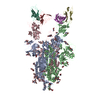 6xcmC 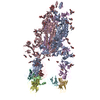 6xcnC  3u36S S: Starting model for refinement C: citing same article ( |
|---|---|
| Similar structure data |
- Links
Links
- Assembly
Assembly
| Deposited unit | 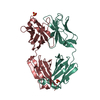
| ||||||||
|---|---|---|---|---|---|---|---|---|---|
| 1 |
| ||||||||
| Unit cell |
| ||||||||
| Components on special symmetry positions |
|
- Components
Components
| #1: Antibody | Mass: 24634.453 Da / Num. of mol.: 1 Source method: isolated from a genetically manipulated source Source: (gene. exp.)  Homo sapiens (human) / Plasmid: p3BNC / Cell line (production host): HEK293 / Production host: Homo sapiens (human) / Plasmid: p3BNC / Cell line (production host): HEK293 / Production host:  Homo sapiens (human) Homo sapiens (human) | ||||||
|---|---|---|---|---|---|---|---|
| #2: Antibody | Mass: 22879.201 Da / Num. of mol.: 1 Source method: isolated from a genetically manipulated source Source: (gene. exp.)  Homo sapiens (human) / Plasmid: p3BNC / Cell line (production host): HEK293 / Production host: Homo sapiens (human) / Plasmid: p3BNC / Cell line (production host): HEK293 / Production host:  Homo sapiens (human) Homo sapiens (human) | ||||||
| #3: Chemical | | #4: Water | ChemComp-HOH / | Has ligand of interest | N | Has protein modification | Y | |
-Experimental details
-Experiment
| Experiment | Method:  X-RAY DIFFRACTION / Number of used crystals: 1 X-RAY DIFFRACTION / Number of used crystals: 1 |
|---|
- Sample preparation
Sample preparation
| Crystal | Density Matthews: 2.55 Å3/Da / Density % sol: 52 % |
|---|---|
| Crystal grow | Temperature: 293 K / Method: vapor diffusion, sitting drop / pH: 3.5 Details: 150 mM lithium sulfate, 100 mM citric acid, pH 3.5, 18% v/v PEG6000 |
-Data collection
| Diffraction | Mean temperature: 100 K / Serial crystal experiment: N | ||||||||||||||||||||||||||||||
|---|---|---|---|---|---|---|---|---|---|---|---|---|---|---|---|---|---|---|---|---|---|---|---|---|---|---|---|---|---|---|---|
| Diffraction source | Source:  SYNCHROTRON / Site: SYNCHROTRON / Site:  SSRL SSRL  / Beamline: BL12-2 / Wavelength: 0.97946 Å / Beamline: BL12-2 / Wavelength: 0.97946 Å | ||||||||||||||||||||||||||||||
| Detector | Type: DECTRIS PILATUS 6M / Detector: PIXEL / Date: May 22, 2020 | ||||||||||||||||||||||||||||||
| Radiation | Monochromator: double crystal Si(111) / Protocol: SINGLE WAVELENGTH / Monochromatic (M) / Laue (L): M / Scattering type: x-ray | ||||||||||||||||||||||||||||||
| Radiation wavelength | Wavelength: 0.97946 Å / Relative weight: 1 | ||||||||||||||||||||||||||||||
| Reflection | Resolution: 1.8→38.89 Å / Num. obs: 46713 / % possible obs: 100 % / Redundancy: 6.8 % / CC1/2: 0.988 / Rmerge(I) obs: 0.192 / Rpim(I) all: 0.079 / Rrim(I) all: 0.208 / Net I/σ(I): 5.7 / Num. measured all: 318966 / Scaling rejects: 901 | ||||||||||||||||||||||||||||||
| Reflection shell | Diffraction-ID: 1
|
-Phasing
| Phasing | Method:  molecular replacement molecular replacement |
|---|
- Processing
Processing
| Software |
| ||||||||||||||||||||||||||||||||||||||||||||||||||||||||||||||||||||||||||||||||||||||||||||||||||||||||||||||||||||||||||||||
|---|---|---|---|---|---|---|---|---|---|---|---|---|---|---|---|---|---|---|---|---|---|---|---|---|---|---|---|---|---|---|---|---|---|---|---|---|---|---|---|---|---|---|---|---|---|---|---|---|---|---|---|---|---|---|---|---|---|---|---|---|---|---|---|---|---|---|---|---|---|---|---|---|---|---|---|---|---|---|---|---|---|---|---|---|---|---|---|---|---|---|---|---|---|---|---|---|---|---|---|---|---|---|---|---|---|---|---|---|---|---|---|---|---|---|---|---|---|---|---|---|---|---|---|---|---|---|---|
| Refinement | Method to determine structure:  MOLECULAR REPLACEMENT MOLECULAR REPLACEMENTStarting model: PDB entry 3U36 Resolution: 1.8→38.89 Å / SU ML: 0.19 / Cross valid method: THROUGHOUT / σ(F): 1.33 / Phase error: 22.82 / Stereochemistry target values: ML
| ||||||||||||||||||||||||||||||||||||||||||||||||||||||||||||||||||||||||||||||||||||||||||||||||||||||||||||||||||||||||||||||
| Solvent computation | Shrinkage radii: 0.9 Å / VDW probe radii: 1.11 Å / Solvent model: FLAT BULK SOLVENT MODEL | ||||||||||||||||||||||||||||||||||||||||||||||||||||||||||||||||||||||||||||||||||||||||||||||||||||||||||||||||||||||||||||||
| Displacement parameters | Biso max: 61.69 Å2 / Biso mean: 27.1921 Å2 / Biso min: 12.09 Å2 | ||||||||||||||||||||||||||||||||||||||||||||||||||||||||||||||||||||||||||||||||||||||||||||||||||||||||||||||||||||||||||||||
| Refinement step | Cycle: final / Resolution: 1.8→38.89 Å
| ||||||||||||||||||||||||||||||||||||||||||||||||||||||||||||||||||||||||||||||||||||||||||||||||||||||||||||||||||||||||||||||
| LS refinement shell | Refine-ID: X-RAY DIFFRACTION / Rfactor Rfree error: 0 / Total num. of bins used: 17
|
 Movie
Movie Controller
Controller








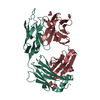
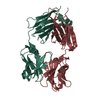
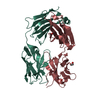
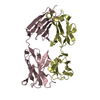
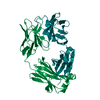
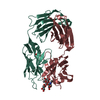

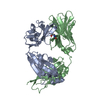
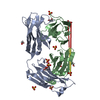


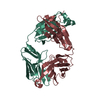
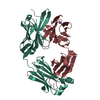
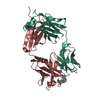
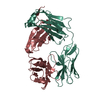
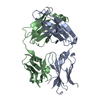
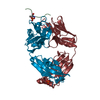
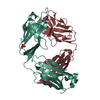
 PDBj
PDBj




